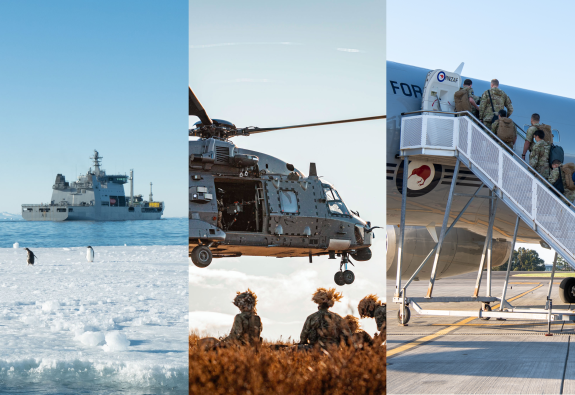NZDF sets out ambitious plan to reduce carbon emissions
The NZDF has unveiled its plan to reduce greenhouse gas emissions, by addressing fuel and energy efficiency, while investigating other long term change options, to help the Government meet climate change obligations and sustainability goals.
02 February, 2023
As part of the Carbon Neutral Government Programme the NZDF aims to reduce gross emissions by 21 percent by 2024/25 and 42 percent by 2029/30, compared to the base year 2016/17. The NZDF has aligned its emissions reduction plan to these science-based targets (Annual Report 2022).
The plan focuses on three major drivers of NZDF emissions: managing fuels; managing commercial travel; and managing Defence estate (energy, electricity, and waste).
It will be underpinned by three enabling lines of effort: data and information; governance and partnerships; and innovation and grassroots action.
Chief of Air Force, Air Vice-Marshal Andrew Clark, Executive Sponsor for the NZDF Climate Change Response Programme (CCRP), said the targets were ambitious.
The NZDF is a military organisation required year-round for a wide range of government-directed tasks. It cannot simply dial back its use of aircraft, ships and other vehicles, which account for about 60-70 percent of the NZDF’s emissions.
NZDF emissions reductions have been tracking below the targets but largely as a result of short-term rather than enduring changes, such as Covid-imposed activity slowdowns and lower activity of ships due to decommissioning, replacement and upgrade projects. Newer equipment is expected to be more fuel-efficient and less emissions-intensive.
The NZDF faces problems similar to other energy-intensive operators, in that current alternative fuel technologies and their supply lines are still maturing for heavy vehicles, aircraft, and ships. They are yet to be proven appropriate for use in military operations in austere conditions, or viable for existing NZDF platforms and equipment to convert to alternative fuel technologies. The support of industry and international military partners will be essential for success.
The plan sets a “direction of travel” for the NZDF regarding its efforts to reduce gross emissions, rather than a detailed set of actions, Air Vice-Marshal Clark said.

Within these two broad areas, there are initiatives already underway:
- The NZDF Electric Vehicle Project
- Investigating the viability of sustainable aviation fuel
- Enhancing business cases to incorporate appropriate whole-of-life cost, benefit and value
- Aligning the NZDF’s commercial travel agent booking system with changes to NZDF travel policy to prioritise lower emissions options
- Coal boiler replacement planning and implementation
- Application of the NZDF Sustainable Infrastructure Standards to new builds and retrofits
- Exploring opportunities for integrating renewable energy sources into Defence energy networks
- Sustainability innovation challenges
Initiatives that will be commenced in FY2023/24 and later include:
- Investigate and identify opportunities to maximise the use of current simulation capabilities and introduce new simulation capabilities
- Investigate viability of sustainable fuels for military land and maritime vehicles and platforms
- Investigate, invest in and incentivise alternatives to commercial travel
- Incentivise continuous improvement leading to emissions reductions
“Climate change is a global strategic challenge that faces everyone,” Air Vice-Marshal Clark said.
It will affect everyone in the NZDF, including the reasons for our operations and how we conduct them. Reducing our own emissions also involves everyone – there is plenty of scope for grass-roots innovation, and we’re already seeing it.
“There are changes we can make now to create more efficient systems and to trial interim solutions, including sustainable fuels and energy.
“In the long term, replacing military equipment with greener technology, although a challenge, will be a priority for the NZDF. In the short term, the pace of change in the New Zealand economy and among military partners makes emissions reductions both a significant challenge and opportunity for the NZDF.”
Background:
In 2018, the Climate Crisis: Defence Readiness and Responsibilities defence assessment concluded that the NZDF needs to be ready to respond to more frequent, possibly concurrent, and more complex security events due to the effects of climate change.
In 2019, Responding to the Climate Crisis: An Implementation Plan established four pillars of action: Respond, Adapt, Mitigate, and Engage.
In 2021, building on both the four pillars of the 2019 Implementation Plan and the work already carried out through the NZDF’s Sustainability Programme, the NZDF established its Climate Change Response Programme. Delivering on CNGP objectives is part of the Mitigate pillar.
In 2022, NZDF publicly disclosed its greenhouse gas emissions since base year of 2016/17, and new emissions reduction targets, as set out in the NZDF Annual Report 2022.
